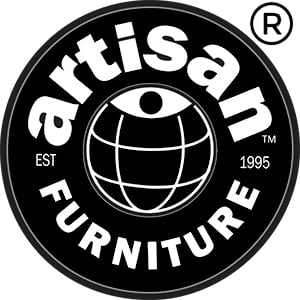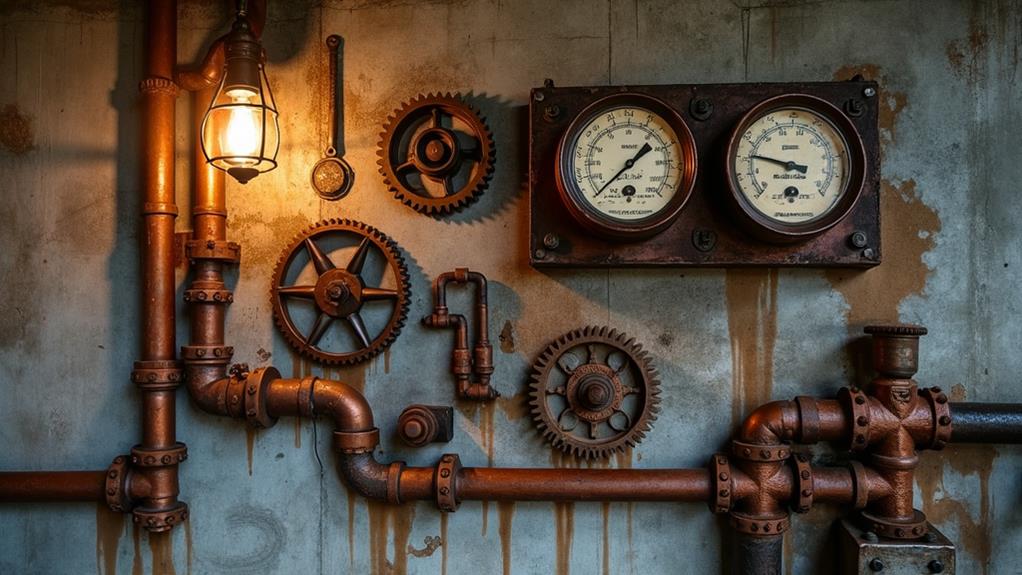You're witnessing a design revolution as salvaged metal decor pieces take center stage in contemporary interiors. This trend marries industrial chic with sustainability, transforming discarded gears, valves, and machinery into stunning focal points. You'll find these unique treasures in scrapyards, antique shops, and online marketplaces, ready to be repurposed as wall art, lighting fixtures, or functional furniture. By blending raw, weathered elements with sleek, modern surfaces, you're creating spaces that tell a story of transformation and rebirth. It's not just about aesthetics; it's a movement that celebrates creativity, reduces waste, and supports local artisans. Dive deeper to uncover the full potential of this enthralling trend.
The Allure of Industrial Chic
From out of the shadows of abandoned factories and warehouses, industrial chic has emerged as a defining aesthetic in modern interior design. You'll find this style characterized by raw materials, exposed structures, and a celebration of utilitarian objects. It's a look that embraces the beauty in imperfection and the stories etched into weathered surfaces.
Salvaged or repurposed items play a significant role in this aesthetic, adding history, uniqueness, and sustainability to interiors. These vintage decor pieces serve as enchanting focal points, enhancing the authenticity and character of the space.
The allure of industrial chic lies in its ability to blend rugged elements with sleek, contemporary spaces. You're not just decorating; you're curating a narrative of urban renewal and sustainable design. Salvaged metal pieces become focal points, transforming your living space into a gallery of functional art.
You'll notice how oxidized steel beams, repurposed gears, and vintage factory lights add depth and character to minimalist interiors. The juxtaposition of rough textures against smooth surfaces creates a dynamic visual interplay. By incorporating these elements, you're not only staying on-trend but also preserving a piece of industrial heritage.
The industrial chic movement challenges you to see beauty in the overlooked and potential in the discarded. It's about creating spaces that are both nostalgic and forward-thinking, where every piece tells a story of transformation and rebirth.
Sourcing Salvaged Metal Treasures
In the midst of your quest for industrial chic decor, sourcing salvaged metal treasures becomes an exciting adventure. You'll find these gems in various unexpected places, from scrapyards and demolition sites to antique shops and online marketplaces.
Keep an eye out for architectural salvage yards, which often house a wealth of metal artifacts from old buildings and factories.
Don't overlook local estate sales and flea markets, where you might stumble upon unique pieces with rich histories. Online platforms like Etsy and eBay can be goldmines for vintage industrial items, offering a wide range of options from around the world.
For larger pieces, consider reaching out to local factories or warehouses that are undergoing renovations or closures.
When sourcing, look for items with interesting patinas, rust patterns, or worn finishes that add character to your space. Gears, pulleys, old signage, and industrial lighting fixtures are particularly sought-after.
Remember to inspect each piece carefully for stability and safety, especially if you plan to repurpose it. With patience and a keen eye, you'll soon curate a collection of salvaged metal treasures that bring authentic industrial flair to your home.
Incorporating Gears and Machinery
Alongside your salvaged metal finds, gears and machinery parts can transform your space into an industrial wonderland. These mechanical elements add depth, texture, and a sense of history to your decor.
Look for oversized gears to create striking wall art or repurpose them as unique table bases. Smaller gears can be clustered together to form eye-catching sculptures or used as bookends on your shelves.
Don't overlook the potential of old machinery parts. Pulleys can be reimagined as pendant lights, while vintage gauges make for intriguing wall clocks. Consider mounting a large industrial valve as a statement piece or using it as an unconventional doorstop.
For a subtler touch, incorporate small machine parts into custom furniture designs, like embedding them in resin tabletops or using them as drawer pulls.
When arranging your gear-inspired decor, aim for a balance between rustic and refined. Pair raw metal elements with sleek surfaces or soft textiles to create contrast.
Balancing Rustic With Refined
While gears and machinery parts inject industrial charm, the true art of salvaged metal decor lies in striking the perfect balance between rustic and refined elements.
You'll want to mix raw, weathered pieces with sleek, polished items to create a harmonious look. Consider pairing a rough-hewn metal table with elegant upholstered chairs, or hanging a rusted factory sign above a modern leather sofa.
To achieve this balance, focus on contrasts in texture and finish. Combine matte, patinated surfaces with glossy, reflective ones. Juxtapose rough, pitted metal against smooth, burnished pieces.
You can also introduce warmth through complementary materials like wood, leather, or plush fabrics.
Don't shy away from mixing metals, either. Copper, brass, and bronze can soften the industrial edge of steel and iron. Use these warmer tones in smaller accents like light fixtures, hardware, or decorative objects.
DIY Metal Decor Projects
Ready to get your hands dirty with some DIY metal decor projects? You'll find that working with salvaged metal can be both rewarding and surprisingly easy. Start by sourcing materials from scrapyards, flea markets, or even your own garage. Look for unique pieces like gears, pipes, or old tools that catch your eye.
For a simple yet striking project, try creating a metal wall clock. Use a large gear as the base, attach smaller gears or washers for hour markers, and add repurposed hands. Mount it on a distressed wood backing for a perfect industrial-chic timepiece.
Transform old metal filing cabinets into stylish storage solutions. Sand them down, apply a matte black paint, and swap out the handles for sleek brass ones. They'll look right at home in a modern office or living space.
For lighting, repurpose metal colanders or sieves into pendant lamps. Drill holes for wiring, spray paint in your desired finish, and add Edison bulbs for a warm glow. Hang them in clusters for maximum impact in your kitchen or dining area.
Lighting Fixtures From Scrap Metal
Delving into the world of lighting fixtures from scrap metal, you'll uncover endless possibilities for creating unique, eye-catching pieces. From industrial-inspired pendants to rustic table lamps, scrap metal can be transformed into functional art that illuminates your space with character.
Start by sourcing materials from salvage yards, scrapheaps, or even your own garage. Look for interesting shapes, textures, and patinas in items like gears, pipes, or old machinery parts. You'll want to clean and prep your finds, removing rust and sharp edges for safety.
When designing your fixture, consider the play of light and shadow. Perforated metal sheets can create mesmerizing patterns, while coiled wire or springs offer a softer glow.
Don't forget about the practical aspects – guarantee proper wiring and heat dissipation.
For a modern twist, combine scrap metal with other materials like glass or wood. A vintage faucet handle could become a chic pull chain, or a collection of mismatched metal bowls could form a striking chandelier.
Sustainable Aspects of Upcycling
Beyond creating stunning lighting fixtures, upcycling scrap metal into decor embraces a sustainable approach to design.
You're not just adorning your space; you're actively reducing waste and minimizing your environmental footprint. By repurposing discarded materials, you're diverting metal from landfills and reducing the demand for new raw materials.
This eco-conscious practice aligns with circular economy principles, extending the lifecycle of metal products.
You'll find that upcycled metal pieces often require less energy to produce compared to manufacturing new items. This process cuts down on carbon emissions and conserves natural resources.
Moreover, you're supporting local artisans and small businesses that specialize in salvaged metal work.
These craftspeople often employ traditional techniques, preserving cultural heritage while innovating for modern aesthetics.
The uniqueness of each piece means you're investing in one-of-a-kind decor that tells a story.
You're not just following a trend; you're participating in a movement that values creativity, resourcefulness, and environmental stewardship.
Caring for Salvaged Metal Pieces
With proper care, your salvaged metal decor can maintain its unique character for years to come. To preserve its industrial charm, start by dusting regularly with a soft, dry cloth to prevent buildup of grime and potential scratches.
For stubborn dirt, use a slightly damp microfiber cloth, but avoid excess moisture to prevent rust.
If your piece shows signs of rust, gently sand the affected area with fine-grit sandpaper, then apply a rust converter primer. For a weathered look, you might choose to leave some patina intact. To protect against future corrosion, apply a clear lacquer or beeswax coating.
For outdoor metal pieces, consider a weather-resistant sealant to guard against the elements. If your salvaged item has moving parts, like gears or hinges, occasional lubrication with food-grade mineral oil will keep them functioning smoothly.
When displaying your metal decor, avoid direct sunlight and high-humidity areas to prevent fading and oxidation. If your piece has a painted finish, touch up chips promptly to maintain its aesthetic appeal and prevent further damage.

